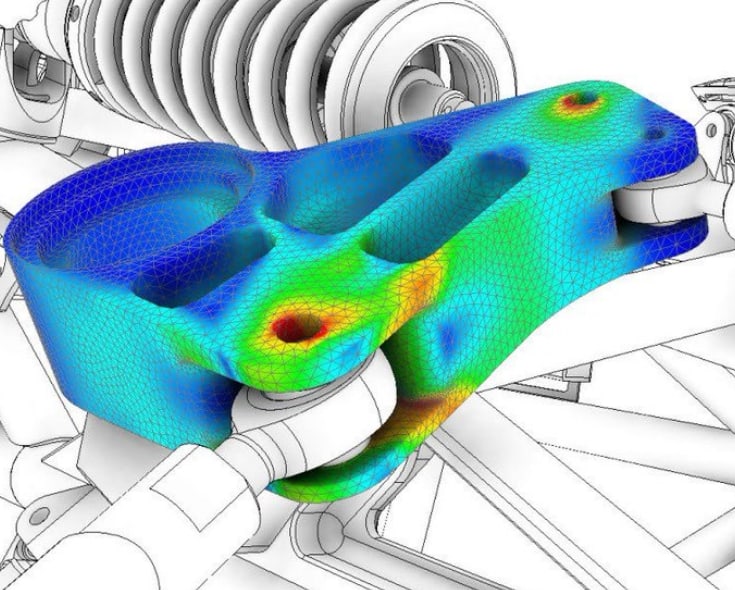Manufacturing problems often occur after the product has been manufactured, assembled, and shipped. Companies should see and address product design problems early in the product life cycle to avoid costly defects or delays. Using simulation-based design for manufacturing techniques and world-class CAE tools, manufacturers and designers rapidly address manufacturing challenges during their product design process, saving time and reducing defects before they occur.
Manufacturers are constantly striving to deliver products faster, better, and cheaper. They often don’t achieve this. The design is too complicated or expensive to manufacture, or the product breaks or fails prematurely.
Solve Manufacturing Challenges Before They Exist
Design for Manufacturing and Assembly (DFMA) is an engineering methodology that combines design for manufacturing (DFM) and design for assembly (DFA) to develop design guidelines. The DFMA method focuses on reducing time-to-market and total production costs by prioritizing the ease of manufacture for a product’s parts and the simplified assembly. All this is done during the early design stages of a product’s lifecycle.
Simulation is used to synthesize and define the physical design. Innovative manufacturers are taking advantage of advances in simulation technology like machine learning and artificial intelligence and development processes to beat their competitors to market with higher quality, longer-lasting products.
Industry 4.0 gives us the ability to do things faster, better, and cheaper. It changes how we look at the entire product lifecycle. We are no longer captives to a physical prototype iterative design cycle but an iterative digital one. Deploying simulation and other CAE tools to inform our design choices.
The Design for Excellence Process
The PPS Design for Excellence (DFX) process is a risk-reducing approach that ensures that all risks are identified, assessed, and monitored. The first step in this process is to define the manufacturing process and company physical assets. Next, the assembly steps are defined and then identified sources of variation using Design for Manufacturing and Assembly (DFMA) Techniques.
- Reducing the number of parts and simplifying the part design.
- Design Parts for Ease of Fabrication and Within Known Process Capabilities and Avoid Tight Tolerances
- Utilize Common Parts and Materials
- Mistake Proof Product Design and Assembly (Poka Yoke)
- Design for Ease of Assembly and Handling Requirements and Part Orientation
- Incorporate Easy and Efficient Fastening Methods
- Modular Product Design
- Design for Automation
Manufacturing simulation software allows product developers to create a virtual representation of their physical parts or products using 3D CAD geometry. By applying real-world physics and conditions to this virtual model, manufacturing engineers can understand how a product will behave without building a physical prototype or equipment.
Simulation modeling helps companies reduce costs by eliminating dependence on costly prototypes and reducing the time needed to test a design before it’s released into production. Digital twins are also helping manufacturers determine how their products will perform in the field once they’re released. The Digital twins capture operational data to ensure that design features meet performance requirements.
Digital Twins and Threads of Industry 4.0
Why continue to fly blind when you can ensure that your products are of the highest quality? With digital twins, you can solve manufacturing challenges before they exist.
The “digital twin,” a virtual representation of the design, is now being used to identify and address potential problems with components and assemblies throughout the manufacturing process. Digital twins are also helping manufacturers determine how their products will perform in the field once they’re released. Ensuring new design features meet performance requirements while solving existing problems.
We’re all about making sure customers are happy and satisfied with our products, but we can’t do that if our products aren’t up to snuff. We can’t send out a product that meets all of our requirements for quality and performance if it doesn’t meet the requirements of the people who use it.
A Digital Twin links the physical and digital worlds of your product. It helps you understand what’s happening with your product and how to improve its performance.
In today’s market, physically seeing your product doesn’t necessarily mean you know what’s going on with it. And yet, if your product doesn’t perform well—if it breaks down or wears out or feels outdated—you will see the effect on customer satisfaction.
That’s where Digital Twins come in. They help us link the two worlds together: performance and customer satisfaction.
Digital Twins help us determine how our products will perform in the field once they’re released, ensuring new design features meet performance requirements while solving existing problems.
Finial Thoughts
In manufacturing, the goal is to produce a product at the lowest price in the shortest time. Suppose you can use manufacturing and design simulation. In that case, you have an advantage over your competitors because you have many more opportunities to make a better design before you even start manufacturing your part.
Knowing in advance what happens when we manufacture parts, we can adjust our designs before they are ever produced. Using digital twins, we can predict what will happen during making and using a part that helps us design more durable products and is less likely to need repair and maintenance…
Are you ready to build new products on leading-edge technologies?
We’d love to have the opportunity to prove our value. Reach out today!









